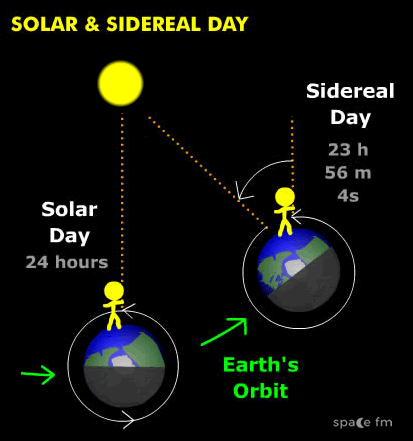The Day
4.1 - Understand the difference between sidereal and synodic (solar) days4.14 - Understand the relationship between sidereal and synodic (solar) time
A solar day is the time it takes the Sun to arrive in the same position as the day before. This happens in exactly 24 hours. This is not the Earth's true rotation though. As the Earth rotates it is also orbiting the Sun. It moves in space.
If we measure the rotation not by the Sun but by a Star then we find the Earth rotates in 23 hours, 56 minutes and 4 seconds.
This is a sidereal day and explains why the Earth rotates 4 minutes earlier than 24 hours.
Likewise, the time it takes for the Moon to show Earth two full moons (29.5 days) is different to its sidereal period of rotation (27.2 days).
Questions
- What is a:
a) Solar day
b) Sidereal Day - Distinguish between a solar and a sidereal day and explain why the Earth's rotation period is 4 minutes less than 24 hours.
Animation
Summary
- Solar Day = Time it takes for the Sun to return to same position in Sky = 24 hours
- Sidereal Day = Time it takes for a star to return to same position in Sky = 23 hours, 56 minutes, 4 seconds
Links
Eric Weisstens, World of astronomy Sidereal day

 | © All Rights Reserved |
| © All Rights Reserved |